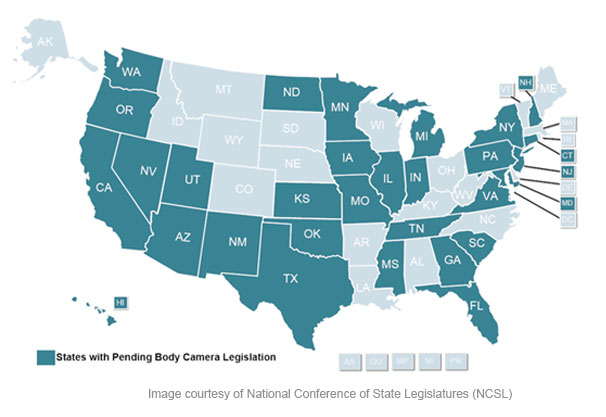FAQs
A two-page Body-Worn Camera (BWC) Law Enforcement Implementation Checklist was created for your download and use in implementing a new body-worn camera program from learning the fundamental all the way to a phased rollout. This guide captures the seven key focus areas to a comprehensive program plan and provided references back to this BWC Toolkit where relevant.
Per the National Conference of State Legislatures, an increasing number of states—30 as of Feb. 20—are considering legislation that address body-worn cameras for police officers.
Proponents of body-worn cameras believe that video and audio recordings of law enforcement’s interactions with the public will provide the best evidence of, and defense to, accusations of police misconduct. They also believe that being on camera reduces some tension between police officers and the public. For example, a field experiment conducted on body-worn cameras with the Rialto, CA, Police Department found that incidents where police used force and community member complaints against police officers were reduced 50 and 90 percent respectively compared to the previous year.
Several municipalities—including Chicago (IL), the District of Columbia, Los Angeles (CA), New York (NY) and Seattle (WA)—have recently implemented body-worn camera programs and their experiences will inform body-worn camera policy moving forward.
While many are enthusiastic about the potential benefits of body-worn cameras, there are practical and constitutional hurdles to their implementation including funding, data storage and retention, open records laws, recording in areas protected by the Fourth Amendment and appropriate regulations for police use. Many of these and other issues are addressed in state legislation.
So far there have been few enactments addressing body-worn cameras by police officers, and all became law in 2014. Pennsylvania (30 Pa.C.S.A. § 901, PA ST 34 Pa.C.S.A. § 901) enacted legislation allowing waterway and game conservation officers to wear body-worn cameras and Vermont (VT ST T. 20 § 2367) enacted a law that, in part, requested a study of their use in conjunction with Tasers. Oklahoma enacted a law classifying video and audio files from body-worn cameras, if kept, as records under their Open Records Law. Oklahoma’s (51 Okl.St.Ann. § 24A.8) law also specified situations where video could be redacted prior to being released including portions that depict the death of a person or a dead body, nudity or the identity of individuals younger than 16 years of age.
Evaluations of BWC programs vary is scope and nature. At a minimum, however, we believe that the implementing agency should consider conducting both process and impact evaluations. The process evaluation should capture the planning and deployment process, including the names of officers who have been assigned cameras. These officers should undergo routine compliance audits to determine whether they are activating their BWC when required by departmental policy. These audit reports should be provided to the officer and their supervisor on a monthly basis, and should be compiled into an annual department wide compliance report. This annual report should be provided to the community’s risk management unit. Impact evaluations vary considerably in their methodological rigor, from one group pre-post studies to randomized controlled trials. Generally, the more rigorous the better. The impact evaluation should, at a minimum, compare various outcome measures by individual assigned a BWC one year pre and postimplementation. Outcome measures examining the impact of the BWC’s might include number of complaints, number of complaints sustained, use of force incidents, and number of resisting arrest incidents. For example, a department might compare the number of complaints one year prior to an officer being assigned the BWC to the one year period following the assignment of the BWC. For many agencies it is helpful to partner with a local college or university to evaluate the implementation of the BWC program, particularly in the programs first few years of implementation.
For more information, see:
Questions from community members are likely to focus on several key issues. The first involves aspects of BWC policy. For example, citizens will likely ask questions such as: when will officers turn the camera on? Do they have to tell me before they turn it on? Can I ask the officer to turn the camera off? Am I allowed to request a copy of the video?
Citizens are also likely to ask privacy-related questions, such as: Are officers allowed to film in my house or apartment? What happens if the officer records my children? Who is allowed to watch the video? Is this video going to end up on the internet or YouTube? Will my neighbor be able to see this video? Citizens may also want to know about the goals of the BWC program. They may ask: Why are police officers wearing BWCs? What does the agency hope to accomplish with BWCs? Will all officers be wearing cameras? BWCs will have a significant impact on citizens, and community buy-in is critical to the success of a BWC program. As a result, Law enforcement agencies should be prepared to provide detailed responses to these and other questions.


